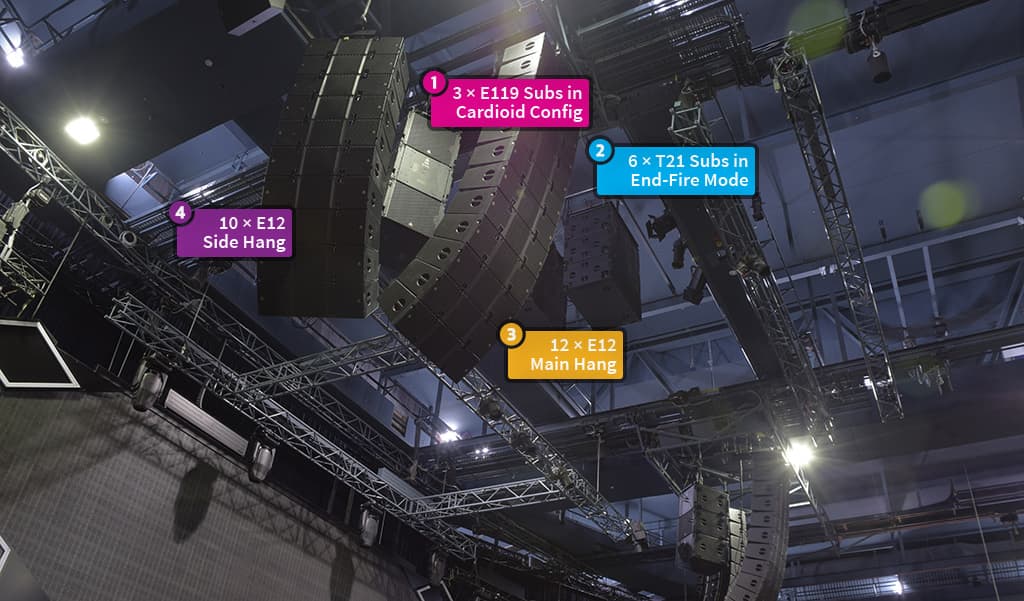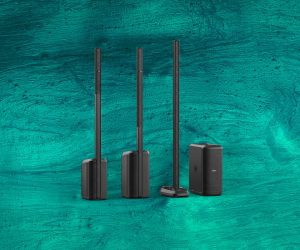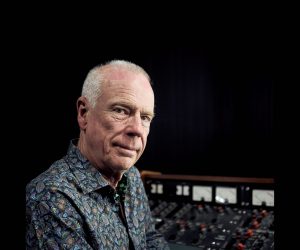
Sunday Best
Hillsong’s quest to be the best is intimidating. Its tech people aren’t. AT finds out what makes the world’s best-known church tick.
Execute; review; improve; repeat.
I normally do my best to ensure the first sentence of an AT story is interesting enough to encourage you, the reader, to proceed to the second. But I thought I’d buck the trend and make a point about Hillsong: it does things better than just about any one else because of a happy coming together of big-organisation processes with small-organisation passion. Put another way: all the tech guys I met for this story really, really care, and they’re happily part of a big structure that allows them to excel.
That’s the story. It’s not sexy or sensational. Yes, there’s a mind boggling amount of great gear to play with. For example, my visit coincided with the commissioning of a new Adamson E12-based PA in the main Hills District campus, but the loading dock was piled high with high-quality kit shipping in and out, as facilities are built and upgraded.
But the real story is the people and their constant striving to do better.
Already there will be a bunch of doubters and haters switching off or cursing this story as a sycophantic Hillsong love-in. I understand that response. When you witness (as I did) 400 shiny/happy Hillsong college students convening for a mid week, midday ‘chapel’ service at the Alexandria campus, with an Adamson rig effortlessly purring away, Barco 12K projectors providing a huge visual panorama, hands in the air, whooping and hugging, it’s hard not to arch an eyebrow and think ‘what the heck is really going on here?’
I think the truth is, it’s really hard for our sceptical Australian brains to get our heads around the motivations. It can’t just be a faith in God, surely? There must be some kinda cultish mind control or money… it always comes down to money.
Even in Christian circles, and in some cases especially in Christian circles, there’s a deep suspicion of Hillsong. But to really wrap your head around what Hillsong does, technically and operationally, you need to accept the church’s topline mission as, dare I say it, gospel. The mission is ‘to reach people’. That’s the motivation. And if you accept that to be true of all the hundreds and hundreds of staff and volunteers, and the reason why they work harder, and constantly aim to improve in every regards, then it all makes sense… in fact, it’s the only way to make sense of it all.

STEPPING UP, STEPPING IN
Steve Le Roux is Hillsong’s Technical Facilities Manager. His key role is to project manage new builds — everything from the audio, AV, lighting, security systems, air handling… the lot. Saying that, he’s an audio guy, and a South African by birth. After spending time in broadcast and recording in his home country he moved to Australia. But not before encountering Hillsong’s senior pastor, Brian Houston, while he was at the Rhema church in South Africa. After emigrating, Steve landed on his feet, scoring a job at the Sydney Opera House where he worked for some 10 years. He was also committing time to Hillsong where his talents didn’t go unnoticed. Steve eventually took up a staff position, project managing the build of a new facility on the Hills campus — he’s been Hillsong’s go-to project manager ever since.
Steve is best placed to explain how Hillsong goes about its business. How it’s possible to pull together huge teams of creatives without ‘clash of the titan’ egos, hissy fits and the endless pulling of rank.
Steve Le Roux: Hillsong is an amazing church. The teaching is about developing and improving people and that trickles right down through all the teams.
Pastor Brian Houston has one vision for the church, and that’s reaching people. All the leaders of all the different departments — youth, kids, etc — they’re all working towards that one vision. Musically as well. The music teams are working towards that vision and we’re there to support them: it’s about taking what the band is doing on a Sunday and ensuring that vision is translated equally to every single seat.
For new talent that means they’re being encouraged, mentored and educated. If we’re training a FOH engineer, that 16-year-old kid might be assisting one of the more experienced guys and for weeks he would just stand there and watch.
Two things come out of that: The young guy’s watching and he’s learning the flow; how to deal with situations, how to deal with the leadership — we’re connecting the person to the role. Eventually, once he’s got to the point where we trust him in that role, he’ll end up mixing, and now the experienced guy is standing back watching him. He may occasionally step in and guide him but that young guy will pretty much be handling the service himself. We’re placing our confidence and trust in that person.
We’re always training because we’re always growing, but our attitude is: if you’re holding onto a role, there’s no room for anyone else. We’re always looking at succession plans, always ensuring we have well-trained people ready to step up and step in.
If you’re a hot shot sound guy and your expectation is you’re going to instantly mix FOH in church on a Sunday; if that’s your attitude, you’re probably never going to get there. If you’re willing to do anything to help — mixing for kids; sound for the youth; mixing in the foyer — and have that humble attitude of ‘wherever you need me, I’m here to help’ — those are the guys that will end up mixing in church.
The same applies to our music team. If you’re not prepared to be ‘just another voice’ in a mass choir, you’re never going to lead worship.
There are over 4000 volunteers at our annual conference. We’ll have doctors and lawyers taking annual leave to serve at that event, helping man an elevator or hand out leaflets. That’s service: ‘wherever you need me, I’m there.’
If you’re a hot shot sound guy and your expectation is you’re going to instantly mix FOH in church on a Sunday; if that’s your attitude, you’re probably never going to get there

AUDIO MILESTONES
Before you think that Hillsong has the newest and best of everything, allow me to introduce you to its 15-year-old Yamaha PM1D on monitors. Or the 10-year old Avid Profile at FOH.
“The guys on monitors aren’t ready to let the PM1D go just yet,” noted Hillsong’s AV and networking guru, Ricki Cook. “But it’s not that uncommon for them to need to reboot the console on a Sunday morning when it can’t find a block of I/O. That’s unnerving. Everyone on the platform is on IEM, so it’s impossible to start a service without a fully functioning monitor console.”
Needless to say, Hillsong is in the process of auditioning new digital mixing consoles.
It’s another stage of a relentless upgrade program. But the PM1D example demonstrates it’s not an ad hoc, finger-in-the-dyke process — it’s measured.
The impetus more often than not comes from the top. If the strategy is to reach people by being better at contemporary worship than anyone else, then you need the gear to achieve that. Similarly, if the desire is to establish new churches around the country and have the ability to ‘simulcast’ the video production up and down the eastern seaboard, you need to invest in some pretty specific gear to achieve that.
I talked to Steve Le Roux about the key generational changes in gear that gave Hillsong a quantum leap.
Steve Le Roux: Upgrading to the Adamson Y10 changed everything [start of 2011]. Up until that point, the system we had wasn’t delivering and it was hurting the team. It was a difficult PA to mix on because it performed differently at one sound pressure level to another level. You couldn’t train and develop people because it was almost like an old gearbox without synchronisation, where you had to build up the revs but you’re grinding away regardless.
The problem was a quirk of the product, the amplification, and the fact the array was too short for the space, resulting in holes in the coverage — as you walked from stage to the mix position you went through maybe six patchy zones. It really was a difficult system. So to use the gearbox analogy again, moving to the Adamson Y10 was like going from a manual gearbox without synchromesh to a smooth automatic.
That upgrade also built up a lot of trust between leadership and the tech team. The system met all expectations, we got it in on budget and the church just lifted — the worship experience was so much better and the message was heard everywhere.
AT: What are you looking for when you audition an item of gear?
SLR: We’re constantly being brought new product to test. Beyond the performance, it’s about the maintenance, and reproducibility in any situation. If a headset is on the pastor it needs to sound the same whoever is on FOH. If one guy can make it sound spectacular but it’s feeding back for everyone else then that’s no good to us.
I remember one headset that came in was super-flexible and I was on a tour with Pastor Brian and I approached him about trying it. ‘Okay we’ll give it a try.’ He bumped his cheek with his hand as he was walking up to the platform and as he went to speak the mic was sticking out 90 degrees to his head. I had to run up and do a roadie fix on it. So needless to say, that headset didn’t make the cut — great product, great idea, but didn’t tick the ‘repeatability’ box.

HIM WHO HAS EARS
AT: You’ve got a large Shure wireless inventory, including lots of channels of IEM. Was the process of switching everyone over to ‘ears’ tricky?
SLR: We started to introduce in-ears on the worship leaders first then just stepped through it. Our backing vocals were on wedges for quite a bit longer, years in fact. Everyone is now on in-ears. We have a few wedges lining front of stage for the preacher now, but that’s it.
Mixing in-ears is mission critical and we put the same level of training into monitors as we do FOH — it’s not a second rate role, it’s as critical, but 12 times over.
Getting the musicians and singers to connect with the congregation is critical. It’s not like a rock ’n’ roll show where you go in there and the band is belting a song out. At Hillsong you’re leading 3500 people in worship through a song and that connection with the congregation is crucial, and that’s the same with the preacher, he’s got to connect.
That first word the preacher utters is critical. If he feels his first word is lost, he’s instantly at a disadvantage. He’s thinking, ‘Have they got this?’ Then he starts feeling insecure and the whole message could be jeopardised by someone not being attentive.
While AT was on site, the church was testing Shure VP88s as ambience mics. The mic is a stereo condenser which Hillsong runs in mid-side mode. The signal goes through the Waves MultiRack where the monitor engineer can play with the stereo width (using the Waves S1 Stereo Imager) for the on-stage team’s ears.
SHOOTOUT HEAVEN
Ever been fascinated by big PA shootouts and what it’d be like to be a fly on the wall and actually experience the nuances in the performance of large-scale arrays? Maybe you should go to church more often! Well, one church at least. Hillsong has its shootout criteria down. Most recently, the Hillsong tech team invited a selection of players to temporarily fly a rig in the Waterloo campus, for a week or so at a time, whereupon all the key operators got a chance to mix a service. Scorecards were handed out among the tech team, the musicians and the leadership.
According to Hillsong’s Steve Le Roux and Ricki Cook, the Adamson was a clear winner, as it was when the Y10 was selected.
Next came a global deal. Adamson’s Australian distributor, CMI, kicked off a discussion and Hillsong soon saw the wisdom. The deal allows the church to standardise its technology, which makes the rollout of new campuses just that little bit easier — not only to design and install but in the training of operators. Part of the deal included upgrading the Hills campus to the newer E12 (the Y10 was about to be superceded when it was installed five years ago), leveraging the latest in Adamson’s driver and waveguide advancements.
The new system is based on two main hangs of 12 x E12 with side hangs of 10 x E12. Spaced dead centre between the main and side hangs are three E119 subs in a cardioid configuration (the middle box is facing backwards). There are a further six T21 subs flown in the centre (in end-fired cardioid configuration) for further LF reinforcement [more on how the system is configured on the previous page].
You’ve got to ask yourself, if Adamson won these shootouts so decisively, what does that mean? Does it mean we can all agree that, at least for now, Adamson has the best performing top-shelf line source systems on the market? And that other vendors are all playing catchup?
Here’s the case for Adamson: Adamson is undoubtedly a premium PA supplier but certainly not the most high profile, so we can rule out the ‘starstruck fanboy’ phenomenon that can sometimes plague a shootout. Secondly, the Hillsong tech team is all highly qualified and personally have a lot invested in getting the process right.
The case for the other vendors: Adamson has a ‘home ground advantage’, having dealt with the church for years. The Hillsong staff loved the voicing of the incumbent Y10, and would naturally gravitate to another (albeit more modern) Adamson system.
Whichever way you cut it, Adamson will have churches with high aspirations beating a path to its door. Hillsong is that influential.

PEOPLE POWER
After my trip to Hillsong, I’m ashamed to say I felt envious. Not envious in a ‘hey, good for you’ way but in an ugly ‘you have so much and I have so little’ way. And I expect many of you may feel the same.
The E12 rig is immense. It’s beyond amazing. And there I was, enjoying a familiar Steely Dan playlist of Roger Nichols, OCD-inspired studio perfection through some of the best PA in the world, admiring the Hillsong tech staff’s collegiality and commitment, when a nagging tick in my brain kept compelling me to look down at the old Y10 rig stacked up on dollies on the floor. ‘It’s such a good rig… Why do you need to upgrade the rolled gold system to the diamond-encrusted platinum option? The old system… let me have your old system…’
Envy isn’t the classiest emotion going around. This is Australia, and Hillsong, having to endure its bi-annual tabloid takedown, understands the tall poppy syndrome better than most.
“The church runs off people’s giving,” reflects Steve Le Roux. “So I always bear that in mind: am I doing justice to the little old lady who’s putting her gold coins into the offering plate?”
It feels incongruous to plead the case for ‘every dollar is sacred’ when you’re chatting in a loading dock stacked with dozens of crates of fine pixel-pitch LED panel from China. But, as we heard from Steve, that’s not to say Hillsong has always had the best of everything or that its stewardship of people’s dough isn’t anything but exemplary. It’s just hard to get your head around.
It’d be naive to think that Hillsong is beyond reproach. It’s not. From the top down, it’s composed of a bunch of humans and one thing we know about humans is that we’re all flawed.
It’s just that this organisation — from the point of view of training, mentoring and supporting audio people, and the way equipment is selected and procured — is the least flawed I’ve seen.
















RESPONSES